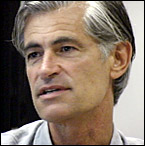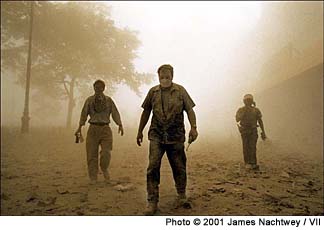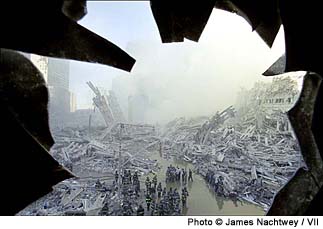It’s eight
p.m. on Thursday evening at Time Magazine nine days after the destruction
of the World Trade Center. Jim Nachtwey is taking a break from editing
the day’s take of his pictures from Wall Street to talk to the
Digital Journalist. It is the ninth day that he has been working on
the story and he looks very, very tired. Although the word “lucky”
seems totally inappropriate applied to anything that happened on September
11th 2001, Time and its readers can count themselves fortunate that
Nachtwey is a contract photographer for the magazine, that his apartment
is in the South Street Seaport complex, and that he was there at the
time that the attack happened. The most remarkable of these circumstances
is the last one. Nachtwey spends more time away from home than in
his apartment. Wherever humanity’s seemingly limitless inability
to live with each other explodes into violence is where you’ll
find him. His work has taken him from Northern Ireland to Korea, from
Afghanistan to Rwanda, from South Africa to Bosnia, Chechnya, Jerusalem
and Kosovo. The list goes on.
 Although
bone weary he speaks with the quiet strength and authority of a man
who has seen more death and destruction in his lifetime than most
people. But even he didn’t expect it literally in his own back
yard:
Although
bone weary he speaks with the quiet strength and authority of a man
who has seen more death and destruction in his lifetime than most
people. But even he didn’t expect it literally in his own back
yard:
“When the attack first started, I was in my apartment in the
South Street Sea Port, directly across Lower Manhattan. I heard a
sound that was out of the ordinary. I’m far enough away so that
it wasn’t alarming but it was definitely out of the ordinary.
It came from the direction of the World Trade Center so I went to
the window and saw the tower burning.”
After shooting some pictures from the roof of his building, Nachtwey
gathered up his cameras and film and took the short ten-minute walk
to the Twin Towers. By the time that he got there the second tower
had been hit, and people were being evacuated from both buildings.
“It wasn’t as chaotic as you might think. I think that the
real chaos was happening up inside the towers with the people who
were trapped. On the street people coming out initially were not seriously
wounded. They were frightened, some were hurt in a minor way, but
I think that the real panic and the real terror and the real chaos
was inside the towers.”
The chaos hit street level when first one and then both buildings
collapsed. People who had been drawn towards the scene now started
fleeing in panic in a futile attempt to outrun the enveloping cloud
of smoke and ash. It was at the point that the second tower fell that
Nachtwey almost became a casualty himself. He tells the story in a
calm, almost matter-of-fact tone of voice:
“Once the tower fell, the people really disappeared. They all
ran away or were trapped. So my instinct was to go to the place where
the tower had fallen. It seemed to me, absolutely unbelievable that
the World Trade Center could be lying in the street and I felt very
compelled to make an image of this. So I made my way there through
the smoke. It was virtually deserted, and it seemed like a movie set
from a science fiction film. Very apocalyptic. Very strange ambiance
of the sunlight filtering through the dust and the destroyed wreckage
of the buildings lying in the street. As I was photographing the destruction
of the first tower, the second tower fell and I was standing right
under it, literally right under it. Fortunately for me, and unfortunately
for people on the west side it listed to the west. But I was still
underneath this avalanche of falling debris, of structural steel,
the aluminum siding of the building, glass; tons of material were
falling directly down on to me. I realized that I had a few seconds
to find cover or else I’d be killed.
"I dashed
into the lobby of the Millennium Hotel, which was directly across
the street from the North Tower, and I realized instantly that this
hotel lobby was going to be taken out. The debris would come flying
straight through the plate glass and just destroy it. There was no
protection at all.
There was no other place to turn, certainly no more time. It was about
to happen any moment. I saw an open elevator and dashed inside. Put
my back against the wall, thinking that it would afford some protection,
which it did, and about a second later the lobby was taken out. I
had seen someone standing outside, and there was a construction worker
who dashed inside the elevator with me just as the debris swept through
the lobby and it instantly became pitch black, as if you were in a
closet with the light out and a blindfold on. You could not see anything.
It was very difficult to breathe. My mouth, my nose, my eyes were
filled with ashes. I had a hat on. I began to breathe through my hat.
And together, this other man and I crawled, groping, trying to find
our way out. I initially thought that the building had fallen on us
and that we were in a pocket because it was so dark. And we just continued
to crawl and I began to see blinking lights…. small blinking
lights… and I realized that these were the directional lights
of cars that have been destroyed and the directional signals were
still on. And at that point I realized that we were in the street,
although it was just as black in the street as it was in the hotel
lobby, and that we would be able to find our way out. It took a couple
of blocks to get clear of the smoke and we made our way out.”
 It
is common wisdom that in battle, whether you’re photographing
or fighting, those with the least experience that are the most likely
to be killed. Nachtwey’s familiarity with life-threatening situations
played an important part in him being able to survive the collapse
and to continue to work.
It
is common wisdom that in battle, whether you’re photographing
or fighting, those with the least experience that are the most likely
to be killed. Nachtwey’s familiarity with life-threatening situations
played an important part in him being able to survive the collapse
and to continue to work.
“It was all instinct and I was making very fast decisions with
very little time to spare. And I guess that I made the right decisions
because I’m still here. And I think that I was lucky too. I don’t
fold up in these situations. I’ve been in them enough times to
somehow have developed the capacity to continue to work…to continue
to do my job…to continue to go forward. On my way out of the
smoke and ash, I was actually photographing searchers coming in. Once
I got clear I tried to clear my eyes as best I could and catch my
breath, and I realized that I had to find my way to what now has become
known as “Ground Zero.” It took a while. I had to work my
way there. I had to elude some people who were trying to obstruct
me and found a way in, and once I was there I spent the entire day
there, photographing the firemen searching for people who’d been
trapped.”
Although the fall of the second tower was the biggest threat to his
personal safety, in many ways his first view of Ground Zero was the
most traumatic.
“I was in a state of disbelief. It was very disturbing to see
this massive destruction in my own city, in my own country. The scenes
were very familiar. I’ve been in Grozny when it was being pulverized
by Russian artillery and aircraft bombardment. I spent a couple of
years in Beirut during various sieges and bombardments. So this kind
of destruction was familiar to me, but now, it was literally in my
own backyard. And I think that one thing that Americans are learning
from this is that we are now part of the world in a way in which we
never have been before.”
While the landscape was familiar those peopling it were different.
“The frontline troops in this particular battle were the firemen
and they put themselves in jeopardy. A lot of them lost their lives.
But they were frontline troops without killing anyone; they were going
there to save people. That made it very different.”
The other difference was the absence of visible casualties, and this
complicated Nachtwey’s emotional response to the scenes that
he was photographing. In the late eighties LIFE magazine assigned
him to do a story about the famine that was happening in the Sudan.
They supplied a tape recorder for him to record his feelings at the
end of the day’s work, and these recordings were to provide the
text accompanying the photography. When he returned he had superb
pictures, but the tape cassettes were empty. The reason? He was worried
that talking about his experiences, even to a tape recorder, would
diffuse his anger, and that he needed the anger to keep his photography
sharp. At the World Trade Center it was not easy to use this motivation.
 “I
think because I didn’t see the dead. They were underneath and
it wasn’t clear how many were under there at that moment. I didn’t
witness people suffering because they were invisible. I didn’t
feel it as strongly as for example when I went to someone starving
to death, to see people cut down by sniper fire. It hadn’t hit
home like that yet. It was really more kind of shock and disbelief.
The anger is certainly building. I don’t think I’ve entirely
dealt with this emotionally I’ve been so busy working. I haven’t
completely processed this event.”
“I
think because I didn’t see the dead. They were underneath and
it wasn’t clear how many were under there at that moment. I didn’t
witness people suffering because they were invisible. I didn’t
feel it as strongly as for example when I went to someone starving
to death, to see people cut down by sniper fire. It hadn’t hit
home like that yet. It was really more kind of shock and disbelief.
The anger is certainly building. I don’t think I’ve entirely
dealt with this emotionally I’ve been so busy working. I haven’t
completely processed this event.”
Another unfamiliar aspect of the situation for Nachtwey was working
side by side with local photographers, many of whom he didn’t
know. Given the nature of his work he rarely shoots in New York, and
is unfamiliar with many of his hometown colleagues. Their work on
this story has earned his unqualified admiration:
“I have never seen more amazing pictures from so many photographers
as this story. New York must be full of incredibly talented photographers
who probably very rarely have a chance to show what they can do at
this level. The imagery has been stunning. I suppose a lot of people
I’m not aware of, haven’t been aware of because I don’t
shoot that much here myself. I don’t know the local photographers.
I have a huge amount of respect for their talent.”
That these photographers showed a high level of professionalism was
also gratifying to see. Under the circumstances this boiled down to
respecting the rescue workers and not impeding their efforts.
“I think the measure of professionalism there was how they dealt
with the rescue personnel. Were they getting in the way? Were they
getting too assertive? Too aggressive? And interrupting the flow of
the rescue operation, and I never saw anyone interfering in the least
way with any fireman, any policeman, any ambulance. Everyone was extremely
sensitive, extremely aware of where they were, what was going on and
what was called for.”
As the result of this behavior there was very little animosity shown
by the rescuers to the photographers.
“I think that the rescue workers were generally too busy to pay
us much mind. And because we weren’t getting in their way they
didn’t have to pay us much mind unless they felt like it for
whatever personal reason they might have. The police were another
matter. I think they instinctively try to keep us away from anything.
I think that it’s just the nature of the relationship, unfortunately.”
He was also impressed with the way that publications reacted and the
amount of space that they devoted to still images. It was as if journalism
suddenly rediscovered its roots, and the public responded. Newspapers
and magazines around the country were selling out. Even the new media
scored some notable milestones. The first day that Nachtwey’s
pictures were posted on time.com there were over two million page
views, the equivalent of more than six hundred thousand people in
just one twenty four hour period. Another notable achievement was
that for the first time during the days following the tragedy the
number of people visiting news sites on the Internet outnumbered those
seeking pornography. We shall have to wait and see whether this is
the beginning of the rebirth of photojournalism as some people have
been predicting, but Nachtwey is optimistic.
“I hope publishers and editors pay attention to this. I think
that there is power in the still image that doesn’t exist in
other forms. I think that there’s even is a necessity for it
because that many people wouldn’t be looking at still pictures
unless they needed to. Six hundred thousand people looking at my website
is small compared to a television audience, but I think that number
is significant. This is sort of a test case of mass appeal.”
Throughout the interview the level of stress and exhaustion was apparent
on Nachtwey’s face, in his body language and in his voice. He
is a man who is used to pushing himself to the limit, but there has
to come a point where that limit stops. After more than twenty years
of exposure to danger and conflict, anguish and despair, violence
and chaos most people would cry enough. Not him, not yet.
“Many years ago felt that I’d seen too much and that I didn’t
want to see any more tragedies in this world. But unfortunately, the
world continues, history continues to produce tragedies. And it is
very important that they be documented in a humane way, in a compelling
way. And because I’ve established credibility in the press…I
feel the responsibility to continue. But believe me when I say that
I would much rather these things never happen and I can either photograph
something entirely different or not be a photographer at all. That’s
not the way the world is. As far as I can see right now I am still
healthy I understand the value in it and I think I still have a place.
Having a place is a privilege and a responsibility that I cannot turn
my back on. I have to continue.”
Looking back on the mindless criminal act of September 11th, 2001
it is frighteningly clear that retirement for James Nachtwey is many
years away.
©
2001 Peter Howe
Enter
James Nachtwey's Photo Gallery
 Although
bone weary he speaks with the quiet strength and authority of a man
who has seen more death and destruction in his lifetime than most
people. But even he didn’t expect it literally in his own back
yard:
Although
bone weary he speaks with the quiet strength and authority of a man
who has seen more death and destruction in his lifetime than most
people. But even he didn’t expect it literally in his own back
yard: It
is common wisdom that in battle, whether you’re photographing
or fighting, those with the least experience that are the most likely
to be killed. Nachtwey’s familiarity with life-threatening situations
played an important part in him being able to survive the collapse
and to continue to work.
It
is common wisdom that in battle, whether you’re photographing
or fighting, those with the least experience that are the most likely
to be killed. Nachtwey’s familiarity with life-threatening situations
played an important part in him being able to survive the collapse
and to continue to work. “I
think because I didn’t see the dead. They were underneath and
it wasn’t clear how many were under there at that moment. I didn’t
witness people suffering because they were invisible. I didn’t
feel it as strongly as for example when I went to someone starving
to death, to see people cut down by sniper fire. It hadn’t hit
home like that yet. It was really more kind of shock and disbelief.
The anger is certainly building. I don’t think I’ve entirely
dealt with this emotionally I’ve been so busy working. I haven’t
completely processed this event.”
“I
think because I didn’t see the dead. They were underneath and
it wasn’t clear how many were under there at that moment. I didn’t
witness people suffering because they were invisible. I didn’t
feel it as strongly as for example when I went to someone starving
to death, to see people cut down by sniper fire. It hadn’t hit
home like that yet. It was really more kind of shock and disbelief.
The anger is certainly building. I don’t think I’ve entirely
dealt with this emotionally I’ve been so busy working. I haven’t
completely processed this event.”